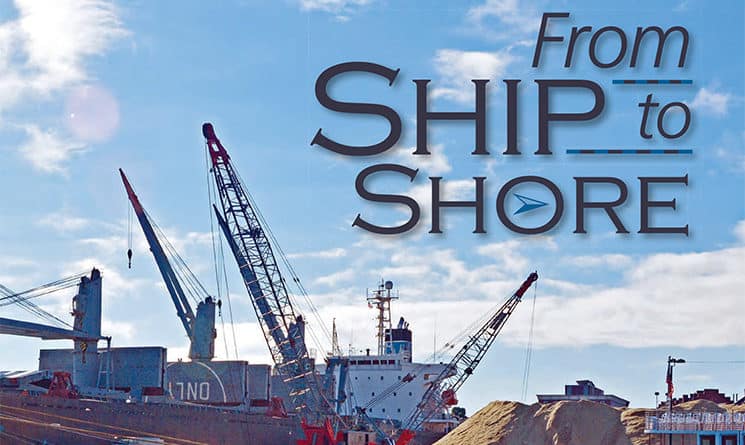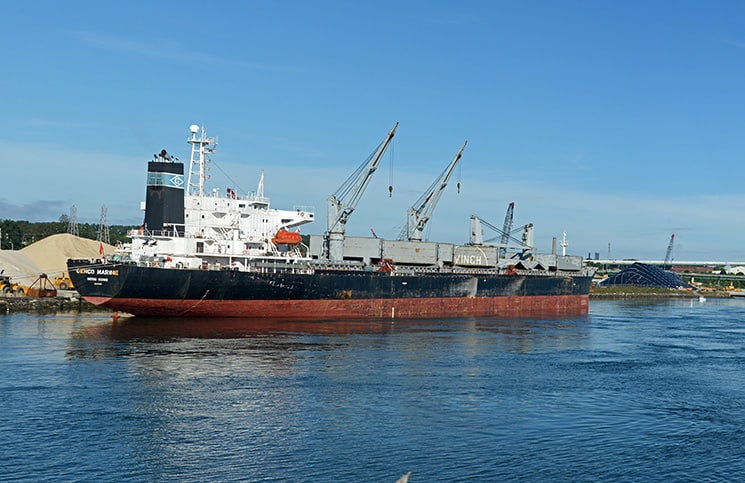It’s easy to forget that Portsmouth has a working port. The marine terminal is located on Market Street, just outside of downtown, and unless you’re taking a cruise with the Isles of Shoals Steamship Company, there are few reasons to walk in that direction. If you’re driving north on Market Street, it’s easy to miss the port, especially since the departure of the massive pile of scrap metal that was formerly stored there by Grimmel Industries.
There are few aspects of life in Portsmouth — and in New Hampshire — that the port doesn’t touch. Over Labor Day weekend, Geno Marconi, director of ports and harbors for the state, watched as workers unloaded 44,000 metric tons of road salt from Chile into the port. The salt was piled into a huge mountain and covered with a black tarp. In a few months, when winter begins, that mountain will shrink as the salt is spread over local roadways. Home heating oil, kerosene, diesel, propane, and dozens of other types of cargo make their way through the port.
“People statewide understand the importance of having a working port,” Marconi says.
Keeping the port working is an ongoing challenge, though. When the Pease Development Authority, which oversees the New Hampshire Port Authority, chose not to renew its contract with Grimmel Industries last year, the port lost a long-time tenant and a significant portion of its operating revenue.
“The bottom line is that we look at base tenants (like Grimmel) so we can keep the facility open,” Marconi says.
“A big part of what we see our job as is to support the other facilities on the river.” — Geno Marconi, state director of ports and harbors
The port is currently the staging area for construction of the new Sarah Long Bridge between New Hampshire and Maine. According to Marconi, the contract with the Maine Department of Transportation lasts through 2017. Now, Marconi and others are looking toward the port’s future, and some area residents are hoping the port will soon start transporting people as well as cargo.
Along the river
The Port of New Hampshire is the center of a complex economic and political ecosystem. Day to day operations fall under the state Division of Ports and Harbors, which was a stand-alone agency until it merged with the Pease Development Authority in 2001. The division oversees marine traffic coming into and going out of the harbor. That means working with the 16 privately owned companies that operate along the Piscataqua River, according to Marconi, as well as working with the Portsmouth Naval Shipyard across the water in Kittery, as well as state agencies like the Department of Environmental Services and Fish and Game, which dock their boats next to the Market Street terminal.
“A big part of what we see our job as is to support the other facilities on the river,” Marconi says. Those companies employ some 1,500 people and pay out $92 million a year in wages and benefits, he says. That alone makes the port an integral part of the region’s economy.
The port’s operation and maintenance budget is about $3 million a year, and, according to Marconi, the port has been self-funding since 2001. The biggest drains on the budget have been upgrades mandated by federal security regulations and environmental regulations.
“We have not asked the legislature for operating or maintenance funds,” he says.
The key to keeping revenue coming in is having a base of tenants at the port. The massive delivery of salt that came in a few weeks ago belongs to Morton Salt, which, along with the Long Bridge construction crew, are the port’s two major tenants.
“We know down the road the bridge construction is going to be completed, and then it’s a question of what do we put in there to replace it?” Marconi says.
Bringing a new tenant — and new cargo — into the port isn’t easy. The pier (first built in 1964, with an addition constructed in 1977) is too small to dock some large ships and accommodate certain types of cargo. The harbor’s unique layout and tidal patterns can also make travel difficult.
Along with those considerations are the economics behind national and international trade. “People say to me, ‘Such and such a port is bringing in this cargo. How come you’re not doing that?’ That’s the difficult part,” Marconi says. “It’s not like I own the terminal and I own the cargo being handled.”
Portsmouth to Provincetown
Bob Hassold, a member of Promote Our Port (POP), thinks the port’s future lies in moving not just goods but also people. About a dozen members make up the group, which Hassold says formed two years ago to advocate for replacing Grimmel’s scrap pile with another business (the scrap metal was leaching pollutants into the Piscataqua River, and was considered by some to be unsightly). Since then, POP has shifted its focus. Now, it’s advocating for a ferry service that will connect Portsmouth with Provincetown, Mass., on the tip of Cape Cod.
The group began exploring the idea earlier this summer, when it met with selectmen in Provincetown. Hassold said the group has invited Provincetown officials to Portsmouth in October to talk about plans for a ferry service.
“If we don’t talk about it or think about it or do something about it, it’ll never happen,” he says.
Such a service almost began in 2001, when Boston Harbor Cruises proposed a Portsmouth-Provincetown route. But a contract was never signed and the boat that would have been used was sold.
“If they thought back in 2001 that a ferry service was viable, why in the world would anyone think a ferry service wouldn’t be viable in 2015, or 2016, or 2017?” Hassold says.
Chris Holt has been working on the tugboats that lead ships into and out of the harbor since 1999. A tugboat pilot with Portsmouth Pilots, Holt says that while “we’d like to see anything and everything coming in and out” of the port, a ferry service seems unlikely. The Piscataqua’s currents make it difficult to navigate, and though there are plenty of tourists who come to the region, Holt thinks it’s unlikely there are enough to support regular ferry runs.
“You might have a big draw initially, a few people might want to do it, but is that going to sustain a company? Nobody wants to come up here to prove a point. People want to make money,” he says.
Looking ahead
Hassold hopes a ferry service is up and running by 2020 — that’s the year Pronvincetown celebrates the 400th anniversary of the Pilgrims’ landing at Plymouth Rock, and it’s just three years before Portsmouth celebrates its own 400th birthday. The opportunities for a multi-state, multi-year celebration are numerous, he says.
In the meantime, Marconi remains focused on finding a new long-term tenant for the port. There are upgrades in store that could help bring in new cargo, including expanding the pier and a federal project to expand a turning basin near Newington.
“The future for us is to find another base cargo or cargoes and push ahead for revenue for improvements and upgrades,” he says. “We don’t want to find ourselves unable to address the potential for future business.”


